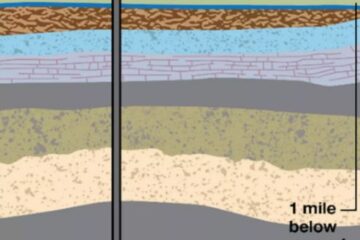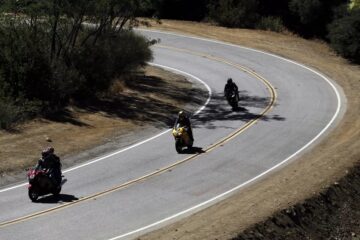Mothers of the Santa Monica Mountains
Three women fought to create the Santa Monica Mountains parkland now burned by the Woolsey fire
Source of this article: The Los Angeles Times, December 2, 2018
The Woolsey fire was a 14-mile-long wall of flames when, on the morning of Nov. 9, it jumped the 101 Freeway and began tearing through the Santa Monica Mountains.
Less than a week later, the National Park Service confirmed that the fire had burned nearly 88% of the federal parkland in the Santa Monica Mountains National Recreation Area.
Most Angelenos have enjoyed this expansive network of parkland, even if they don’t know it. Anyone who has spent a day at the beach in Malibu, hiked in Runyon Canyon or gone horseback riding in Will Rogers State Historic Park has taken advantage of the national recreation area.
And yet, four decades after it was created, many residents don’t fully appreciate how vast the chain of parks is, or how remarkable its origin story.

Advocates Jill Swift, left, Sue Nelson, middle, and Margot Feuer in 1978, the year a national park was created in the mountains above Malibu. Much of the park burned in the Woolsey fire.
The Santa Monica Mountains National Recreation Area is one of the largest urban parks in the country. Spread across more than 150,000 acres and more than 25 ZIP codes, it’s a crazy quilt of open space owned by federal, state and local agencies, all overseen by the National Park Service.
The land preserve is the result of years of dogged advocacy on the part of a handful of local conservationists who went head to head with generations of developers. These epic battles over land use began decades before the recreation area was created.
Disagreement over what to do with the Santa Monica Mountains started as early as the 1920s, when a real estate developer named Alphonzo Bell proposed dynamiting part of what is now Topanga State Park to create a limestone quarry.
Sylvia Morrison, a wealthy resident of Pacific Palisades, pushed back, lobbying instead for a protected park, to be called Whitestone National Park. “Our heritage of the hills must not be wasted,” Morrison stated at a 1928 hearing on the matter. Bell’s plan to create a quarry ultimately collapsed, and so did Morrison’s proposal to create a park.
The 1960s brought a far more contentious wave of confrontation over the fate of the Santa Monicas. The postwar boom had sparked an extraordinary amount of development throughout California. Parts of the Santa Monica Mountains were being leveled to make way for large housing developments. One plan involved converting canyons in the Santa Monicas into landfills, another proposed filling in Malibu Canyon to build a multilane freeway.
As a growing number of developers fixed their eyes on the mountains behind Malibu, a grassroots response began to mobilize. In 1964, a longtime local, Sue Nelson, founded a group called the Friends of the Santa Monica Mountains, Parks and Seashore. In 1965, Marvin Braude ran for Los Angeles City Council for the first time, and won, largely because of growing opposition to a proposed highway that was to cut through the mountains.
Over the following decade, Nelson fought hard to create a national recreation area, along with two other local activists. Margo Feuer, a Malibu resident who worked for years to protect land on the coast and became a Sierra Club lobbyist in order to advocate for the park plan. Jill Swift, a homemaker and passionate naturalist, founded an outfit called the Santa Monica Mountains Task Force and led public hiking events to build support for a national park and to oppose development.
Nelson, Feuer and Swift repeatedly went up against development interests who had deep pockets and political connections. Together, these three women came to be known as the “mothers of the Santa Monica Mountains.”
Their efforts ultimately culminated in legislation that created a preserve stretching from Franklin Canyon to Point Mugu. This swath of parkland was established as part of the National Parks and Recreation Act of 1978.
Although the “omnibus park bill,” as it’s known, was authored largely by Congressman Phillip Burton of San Francisco, the section on the Santa Monicas was written by Congressman Anthony Beilenson, a local lawmaker, in consultation with Nelson. The bill passed despite opposition, and the recreation area was signed into existence by President Jimmy Carter.
The following year, the California Legislature formed two groups: the Santa Monica Mountains Conservancy, an organization that purchases and oversees parkland; and the Mountains Restoration and Conservation Authority, which manages and improves the acquisitions. These agencies have enabled the state to acquire key sections of parkland that the federal government wouldn’t fund.
Over the past 40 years, with a brilliant and occasionally ruthless executive director in Joe Edmiston, the conservancy has successfully acquired 60,000 acres of additional open space. One of its first acquisitions, made in 1980, was Paramount Ranch, the first National Park Service property to be incorporated into the recreation area, and, in 1985, Solstice Canyon Park. (Nelson, Feuer and Swift all died in recent decades.)
A large portion of the park is now scorched. The Woolsey fire tore through Solstice, Zuma and Trancas canyons, as well as the Peter Strauss Ranch and Paramount Ranch. It jumped Pacific Coast Highway in multiple places, burning to the ocean at El Matador State Beach, Leo Carillo and even Westward Beach on Point Dume, an area that hasn’t burned since 1935.
Although much of the national recreation area burned in the Woolsey fire, the park helped save human lives. The Santa Monica Mountains are a fire corridor that has burned repeatedly, and it will burn again.
If the ridges and canyons that now make up the recreation area were packed with the high-density development once envisioned by planners, the outcome of the Woolsey fire, in human lives, could have been exponentially worse. Conservation sometimes conserves more than we realize.



0 Comments